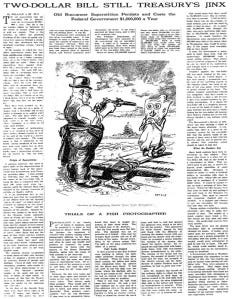Two-Dollar Bill Still the Treasury’s Jinx
Last month, the U.S. Treasury discontinued the penny, in part because there were far too many in circulation. 100 years ago, a New York Times Magazine article contended that there weren’t *enough* $2 bills in circulation.
The journalist William A. Dupuy wrote that it was because of an old superstition:
The buccaneers were suspicious of this silver two-dollar piece. It was thought to carry a jinx with it – because the number of reales in it was the “unlucky” thirteen. Their superstition pervaded the West Indies, and from there spread to the mainland and planted itself in Spanish Florida and French Louisiana and throughout the South. It has there survived all these years, and is still to be reckoned with.
The Treasury Department at Washington has been annoyed by the over-strong run on one-dollar bills. It looks as if, because of a mere superstition, they were being called upon to do their own work and that of the two-dollar bills also.
As a result, the ratio at the time of $2 bills to $1 bills was extremely skewed – only about 8:100.
Today, the ratio is a little higher but not much, at around 11:100.
In the past century, average prices have gone about 18.6x. So a $1 bill back in 1925 would be worth around $18.58 today… while a $2 bill would be worth $37.16.
In 1966, the government actually stopped printing the $2 bill entirely for a decade, until bringing it back in 1976.
In May, the Treasury Department announced it would stop circulating new pennies next year in 2026. because it’s so little-used and actually costs more than 1 cent to produce. The nickel is also little-used and costs more than 5 cents to produce, yet that will continue to be minted… at least for now.
Two-Dollar Bill Still Treasury’s Jinx: Old Buccaneer Superstition Persists and Costs the Federal Government $1,000,000 a Year
Published: Sunday, June 21, 1925


